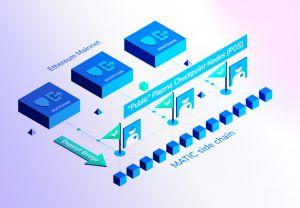MATIC
Polygon
Polygon Network and its MATIC token are two building blocks of the Polygon Layer-2 scaling solution. Launched as the Matic Network and rebranded as Polygon, the network is designed to bring instant and scalable blockchain transactions paired with easier everyday payments and lower fees.
| Market Cap | Volume 24h | Circulating Supply |
|---|---|---|
| $7,537,716,928 | $556,625,411.19 | 8734317475.0 MATIC |

What Is Polygon Network?
Polygon has made headlines based on its promise of delivering simpler interaction between users and decentralized financial applications and ecosystems. Self-described as a Layer 2 scaling solution (meaning that it does not seek to upgrade the basic blockchain layer), Polygon is all about reducing the complexity of this interaction which is identified as bringing down some crypto-based projects.
To achieve this, Polygon was built as a decentralized platform running on a customized iteration of the Plasma framework, which is seen as the solution tasked with bringing massive scaling capability to Ethereum. As proposed by Vitalik Buterin, this framework is supposed to allow for the easier execution of scalable and autonomous smart contracts, thus allowing for the creation of globally available decentralized financial applications on a single foundational blockchain. It will focus on the applications with which there is no need to record each transaction on a blockchain, such as small-scale daily purchases. To this mix, Polygon added the implementation of sidechains and a network of Proof-of-Stake (PoS) validators to ensure better asset security.
What Is Polygon Trying To Achieve?
The Polygon Network comes packed with features that its developers promote as solutions to the prominent issues faced by contemporary crypto technologies.
Polygon seeks to stimulate mass adoption by resolving problems with scalability. These issues stem from the fact that blockchain ecosystems have a hard time keeping pace with the popularity of decentralized apps, particularly in terms of scaling with the existing demand. Based on the projections presented in the Matic Network's whitepaper, this platform will be able to achieve theoretical speeds of up to 65 000 transactions per second on a single side chain, combined with the block confirmation times of less than 2 seconds.
At the same time, the platform features a decentralized Plasma operator system, with finality taking place on the main chain. In addition to this, the Network developers promise an easy addition of new horizontal side chains to support even more transactions on the basic Polygon Chain. Based on this, the Network sees itself as helping not only payment systems but gaming networks and decentralized exchanges as well.
Polygon promises to make slow transactions a thing of the past without compromising the principles of decentralization. Based on the Polygon team's projections, the Network's implementation of Proof-of-Stake and its staking mechanism is supposed to clear the obstacles standing in the way of achieving high transaction throughput. Current levels of blockchain transactions are described as suffering from poor performance and limited throughput, partially based on their reliance on PoW (Proof-of-Work) protocols with their limited block sizes and protracted block generation time.
Polygon's PoS consensus model is described as being implemented in a manner that will not harm decentralization and security at the same time. The consensus is ensured by a select team of block producers appointed for each checkpoint (i.e. header block) by the stakers. These producers allow the system to create blocks in an allegedly fast manner. At the same time, decentralization is protected by delegating the PoS checkpoints to the main chain, which is, at least initially, Ethereum. The blocks are validated with the publishing of the periodical proofs of blocks created by the block producers, thus affirming the decentralized mode of operation of the Polygon Network.
- Polygon promises to bring down transactions fees and improve user experience (UX). In addition to purely technological considerations, some blockchain implementations are seen as preventing their mass adoption by applying high gas and similar fees. Considering that the payment of tokens in exchange for services or transactions is the backbone of many crypto projects' micro-economy, the Polygon team opted for the economy of scale as its solution. It features a dedicated layer on which the block producers handle a high number of transactions, thus keeping their costs down. The interoperability and smooth transition from the main chain to the Polygon chain should also improve the UX.
- Polygon supports asset interoperability and multiple micropayment channels compatible with other off-chain solutions. Assets on different sidechains are to achieve interoperability as long as they are provided for by the Polygon Network. As the Polygon Network runs on the state-based system of the Ethereum Virtual Machine (EVM), it does not need an opening of the payment channels between two parties. Thus, a valid Ethereum address is treated as an equally valid Polygon address without requiring a customer to join the Polygon chain in order to be able to receive payments. All that is needed in this case is the possession of a Polygon wallet.

How Does Polygon Network Operate?
Polygon's technical architecture reflects what its developers defined as their priorities when designing their solution. For starters, it is supposed to reduce the waiting time associated with the transfer of ETH and ERC20 tokens on the Ethereum platform, particularly for the use cases involving small-time purchases and daily transactions (ranging anywhere from 14-20 seconds). High fees and peak time network clogging only exacerbate the issue, which Polygon hopes to conquer with the following approach:
- Users make a deposit featuring a crypto asset with the help of the Polygon contract on the main chain.
- Deposited tokens need to be confirmed on the main chain.
- Next, the tokens will be shown on the Polygon chain with the help of the Polygon Deposit bridge. These bridges function as components of the block producer nodes. They keep track of the root contract events on the main chain as well as any related token transfers. This is done with the help of the Polygon's dedicated tool designated as Dagger. The Dagger helps the bridges detect deposits on the main chain to trigger an event on the Polygon chain and ensure that an appropriate address on the Polygon Network receives the deposit in question.
- Once this is done, the users can send tokens in an almost instantaneous manner at reduced fees. At the same time, there is an option to withdraw tokens to the main chain by verifying proof of remaining tokens on the root contract i.e. the one deployed on the Ethereum chain. The same approach is supported for ERC-20 tokens and other fungible assets existing on the Ethereum blockchain.
How Do Consensus and Checkpointing Work on Polygon?
Polygon's Proof-of-Stake consensus mechanism is implemented on its checkpointing layer. This layer plays the role of the host of the PoS stakers. At the same time, the Polygon blockchain layer is the home of the block producers whose numbers are kept low to increase block generation times.
- Any user can decide to deposit/stake their Polygon tokens on the root contract in order to become a staker. In addition to validating transactions, the stakers make proposals regarding the deployment of checkpoints on the main chain. For every few blocks on the block layer, the stakers select a proposer to propose and create checkpoints. The underlying system is based on PoS, with 2/3 majority principle for the approval of a header block i.e. checkpoint.
- Stakers appoint block producers among themselves by voting and task them with creating the Polygon blocks on the blockchain layer. The nomination is confirmed by the evidence of the existence of an adequate stake.
- In addition to securing finality on the main chain, the checkpoints also play a role in withdrawals since they handle the proof-of-burn i.e. withdrawal of tokens. Users can prove the remaining tokens while the withdrawal itself incurs the gas fees.
What Is the Role of the Polygon Token?
Polygon Token is a utility token on the Polygon Network. It is designed to perform several main roles:
- Being a unit of payment on the Network.
- It is used as a means of settlement between users who take part in the operation of the Polygon ecosystem.
- The token is hoped to become a medium of financial incentive for the users who want to make contributions to the Polygon Network and keep its ecosystem alive. They can, for example, provide computational resources and services related to proof publishing and block validation and earn Polygon tokens in exchange.
- As said before, the staking of the tokens is required for participation in the Polygon Network's consensus procedure. Stakers engaging in irregular activities will be punished by having their Polyogn tokens taken from them.
The Polygon Network organized the token sale on the Binance Launchpad platform on April 24, 2019. The sale was the first one to follow a novel lottery format. In early 2019, the Binance exchange announced a new system in which a user can claim up to five tickets to participate in the token sale, whereas the number of tickets depends on the amount of BNB held over a 20-day period. The effort raised some USD 5 million with the successful sale of 1.9 billion available tokens.
As of May 2019, the currency's market cap stood at USD 56 million, with some 2 billion tokens being in circulation out of the planned 10 billion units. The token is available for trade on cryptocurrency exchanges such as Binance, Hotbit, and others. Acquired tokens can be stored in the official Polygon wallet.

The Polygon Team and Partnerships
Polygon boasts a small but dedicated team of professionals. Jaynti Kanani is a co-founder and the CEO of the project. His professional background includes software engineering and data science. Sandeep Nailwal is another co-founder and the COO of Polygon, while Anurag Arjun is the Chief Product Officer.
Polygon's partners include Decentraland, a virtual reality platform powered by the Ethereum, Zebi, a provider of blockchain solutions for governments and enterprises, and MakerDao as a decentralized autonomous organization managing the DAI stable coin.
